Pierre Charles L'Enfant facts for kids
Quick facts for kids
Pierre Charles L'Enfant
|
|
|---|---|
| Born | August 2, 1754 Paris, France
|
| Died | June 14, 1825 (aged 70) |
| Resting place | Arlington National Cemetery |
| Monuments | L'Enfant Plaza, Washington, D.C.; Freedom Plaza, Washington, D.C. |
| Nationality | French and American |
| Other names |
|
| Education | Royal Academy of Painting and Sculpture |
| Occupation | Military engineer, architect |
| Known for | L'Enfant Plan |
| Parent(s) |
|
| Military career | |
| Allegiance | |
| Service/ |
|
| Rank | Brevet major |
| Unit | Corps of Engineers |
| Battles/wars | American Revolutionary War
|
Pierre Charles L'Enfant (August 2, 1754 – June 14, 1825) was a French-American military engineer. He is famous for designing the basic plan for Washington, D.C., the capital city of the United States. This plan is known today as the L'Enfant Plan (1791).
Contents
Early Life and Education
Pierre L'Enfant was born in Paris, France, on August 2, 1754. His father, also named Pierre L'Enfant, was a well-known painter for King Louis XV of France. Pierre Charles was the second son, but became the eldest after his brother died.
He studied art at the Royal Academy in the Louvre. He also learned from his father at the Royal Academy of Painting and Sculpture. When he was 23, he left school in France. He decided to join the American colonists fighting for their freedom in the American Revolutionary War.
Military Service in America
L'Enfant came to the United States in 1777. He served as a military engineer in the Continental Army. He worked with Major General Lafayette. He became a captain in the Corps of Engineers in 1779.
L'Enfant strongly supported the United States. He even changed his first name from Pierre to Peter when he arrived. He worked on General George Washington's team at Valley Forge. While there, he painted a portrait of Washington. He also drew other officers and army camps.
L'Enfant was hurt during the Siege of Savannah in 1779. He later became a prisoner of war in Charleston, South Carolina. After being released, he continued to serve with General Washington. He was promoted to Major in 1783 for his service. He left the army when the war ended in December 1783.
Career After the War
After the American Revolutionary War, L'Enfant started a successful business. He worked as a civil engineer in New York City. He became known as an architect for redesigning New York's City Hall. This building became Federal Hall, where the first U.S. Congress met.
L'Enfant also designed furniture, houses, coins, and medals. He created the eagle-shaped badge for the Society of the Cincinnati. This was an organization for former officers of the Continental Army. George Washington, the first president of the Society, asked L'Enfant to make these badges in France.
L'Enfant was a friend of Alexander Hamilton, a key figure in early American government. Some of their letters are now kept in the Library of Congress.
Planning the Federal City
The new Constitution of the United States allowed Congress to create a special federal district. This district would be the new capital city. L'Enfant wrote to President George Washington, offering to design the city. In 1790, Congress chose the banks of the Potomac River for the new capital.
President Washington chose L'Enfant in 1791 to plan the "Federal City." This city was later named Washington, D.C.. Three commissioners were appointed to help oversee the project. Thomas Jefferson, the Secretary of State, also worked with Washington on the plans.
L'Enfant arrived in Georgetown in March 1791 and began his work. He presented his first plan for the city to President Washington in June. He sent a new map to the President in August.
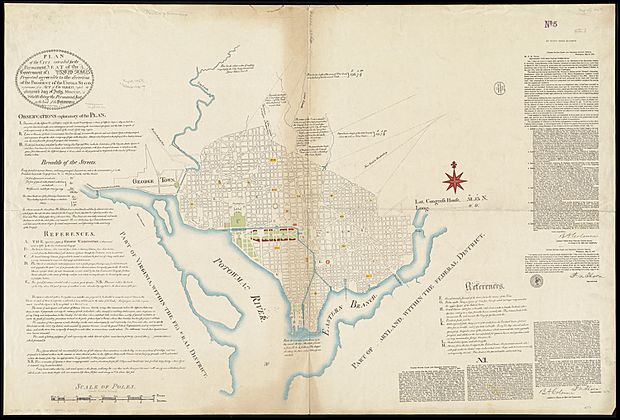
This is a copy of Peter Charles L'Enfant's 1791 plan for the federal capital city.
L'Enfant's plan covered a large area near the Potomac River. It showed locations for two main buildings. These were the "Congress House" (now the United States Capitol) and the "President's House" (now the White House).
He planned the "Congress House" on "Jenkins Hill," which he called "a pedestal awaiting a monument." The "President's House" was to be northwest of the "Congress House." It would be on a ridge overlooking the Potomac River. L'Enfant imagined the "President's House" to be much larger than what was actually built.
The plan showed most streets in a grid pattern. East-west streets were named after letters, and north-south streets after numbers. Diagonal avenues, named after states, crossed the grid. These avenues met at circles and plazas. These open spaces would honor important Americans.
L'Enfant designed a wide, garden-lined "grand avenue." This avenue would be about one mile long and 400 feet wide. It later became the National Mall. He also planned a narrower avenue, Pennsylvania Avenue. This avenue would connect the "Congress House" and the "President's House."
L'Enfant also planned a system of canals. These canals would pass by the "Congress House" and the "President's House." One branch would flow into the Potomac River.
L'Enfant found quarries in Virginia to get stone for the "Congress House." However, his strong opinions and desire to control the entire project led to disagreements. He argued with the Commissioners, who wanted to focus on building the federal buildings with limited money.
Changes to the Plan and L'Enfant's Departure
In February 1792, Andrew Ellicott was surveying the federal district. He told the Commissioners that L'Enfant had not had the city plan engraved. L'Enfant also refused to give him the original plan. Ellicott, with his brother Benjamin, then revised the plan. L'Enfant protested these changes.
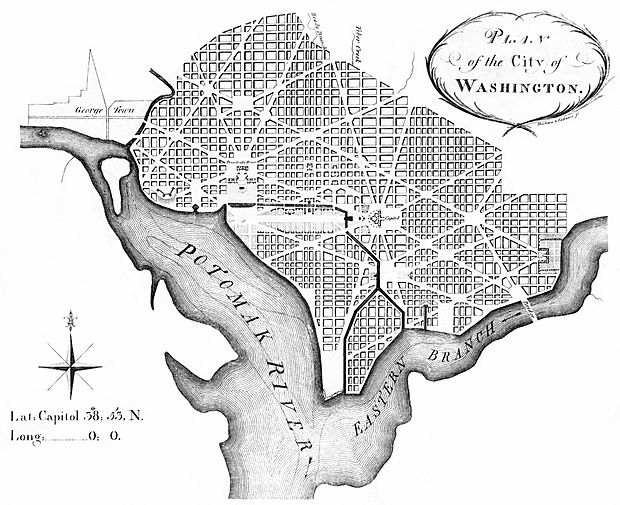
This is Andrew Ellicott's 1792 updated version of L'Enfant's 1791 plan for the "Federal City."
Ellicott said he knew L'Enfant's system well. He had many notes from his own surveys. So, he was able to recreate the plan. Soon after, President Washington dismissed L'Enfant. Ellicott continued the survey using the revised plan. This revised plan became the basis for how Washington, D.C., was built.
L'Enfant's plan for the capital city was influenced by the famous Gardens of Versailles in France.
Other Projects and Later Life
After leaving Washington, D.C., L'Enfant worked on other projects. He made initial plans for Paterson, New Jersey. He also designed a mansion for Robert Morris in Philadelphia, but it was never finished. In 1794, he helped rebuild Fort Mifflin near Philadelphia.
In 1812, L'Enfant was offered a teaching job at the United States Military Academy at West Point. He declined it at first, but later taught there from 1813 to 1817. He also briefly worked on Fort Washington Park near Washington, D.C.
L'Enfant did not plan cities like Perrysburg, Ohio, or Indianapolis, Indiana. However, Alexander Ralston, an engineer who helped L'Enfant in Washington, D.C., used parts of L'Enfant's ideas when designing Indianapolis.
Death and Recognition
Even though the U.S. Congress paid him for his work on Washington, D.C., L'Enfant died poor on June 14, 1825. He was first buried on a farm in Maryland. He owned only a few personal items, like watches, compasses, books, and maps.
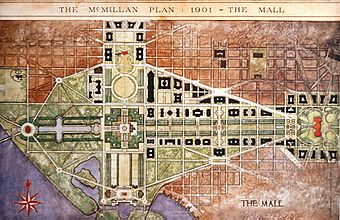
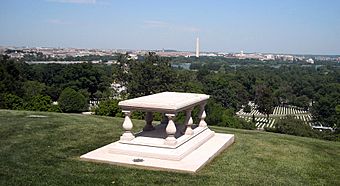
In 1901 and 1902, the McMillan Commission looked at L'Enfant's original plan. They suggested changes to redesign parts of the capital city. Their report included a plan for a large mall in the area L'Enfant had called his "grand avenue." The McMillan Plan has been very important in how Washington, D.C., has grown.
In 1909, L'Enfant's contributions were finally recognized. His remains were moved from the farm. After being honored at the Capitol rotunda, he was re-buried at Arlington National Cemetery in Virginia. His grave overlooks the Potomac River and the city he designed.
In 1911, a monument was placed on L'Enfant's grave. President William Howard Taft spoke at the dedication. The monument has a diagram of part of L'Enfant's original city plan.
Honors and Legacy
- In 1942, a cargo ship during World War II was named the S.S. "Pierre L'Enfant".
- L'Enfant Plaza in southwest Washington, D.C., was dedicated in 1968. It is a complex of office buildings, a hotel, and shops. The plaza has a map of L'Enfant's 1791 city plan engraved on it.
- The L'Enfant Plaza subway station is a busy stop in Washington, D.C.
- In 1980, Freedom Plaza opened in downtown Washington, D.C. It has a marble inlay showing parts of L'Enfant's 1791 plan.
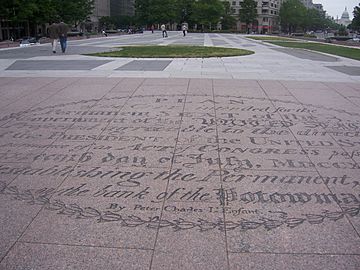
- In 2003, L'Enfant's 1791 Plan for Washington was honored on a USPS postage stamp.
- The Government of the District of Columbia has a statue of L'Enfant. It is displayed in the John A. Wilson Building. Efforts are being made to place it in the National Statuary Hall Collection at the U.S. Capitol.
- Since 2005, the National Building Museum holds an annual "L'Enfant Lecture." This lecture focuses on important issues in city planning.
- The American Planning Association (APA) has an award named after L'Enfant. It recognizes excellent international planning.
Images for kids
See also
 In Spanish: Pierre Charles L'Enfant para niños
In Spanish: Pierre Charles L'Enfant para niños


